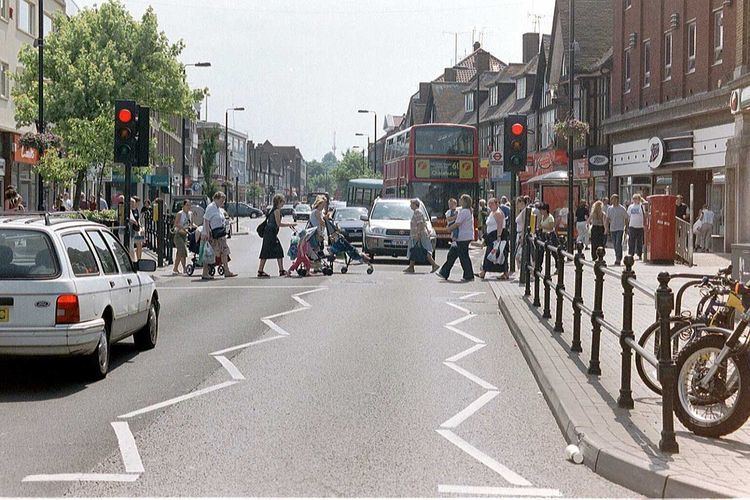 | ||
A pelican crossing (previously Pelicon Crossing – PEdestrian LIght CONtrolled Crossing) is a type of pedestrian crossing, which features a pair of poles each with a standard set of traffic lights facing oncoming traffic, a push button and two illuminated, coloured pictograms facing the pedestrian from across the road. These are a red, stationary person to indicate that it is not safe to cross, and a green, walking person to indicate that it is safe to do so. Pelican crossings also provide non-visual indication that it is safe to cross, such as a beep, vibrating button or tactile rotating cone in order to assist visually impaired pedestrians.
Contents
Details
The name is derived from PELICON, a portmanteau of pedestrian light controlled. The term pelican crossing originated in the United Kingdom, but similar traffic control devices are in use throughout the world. The term is also used in the Republic of Ireland.
The pelican crossing was a relatively minor development of the "x–way" crossing. This earlier crossing was largely identical to the pelican crossing, but instead of a green light for motorists, featured a white diagonal cross. The intention of this was to distinguish the crossing lights from any nearby junction (standard) traffic lights). The white cross was widely criticised and users and motoring organisations alike called for the white cross to be replaced by a green light. With some changes to the light timings and road markings, the "x–way" crossing became the pelican crossing.
In the United Kingdom, the pelican crossing was the first definitive light controlled crossing for pedestrians, introduced in 1969. This was after the earlier failed experiment of the panda crossing. Previously only zebra crossings had been used, which have warning signals (Belisha beacons), but no control signals. The pedestrian lights are situated on the far side of the road to the pedestrian. A puffin crossing has the lights on the same side as the pedestrian; a toucan crossing is a crossing for pedestrians and bicycles; a pegasus crossing allows horse riders to cross as well.
Additionally, a pelican crossing, as distinct from a puffin crossing, has the special feature that while the green man flashes to indicate that pedestrians may continue crossing but may not start to cross, the red light changes to an amber flashing light permitting cars to pass if there are no further pedestrians. This reduces the delay to traffic. Also, pelican crossings can be used to enforce local speed limits by detecting the approach speed of the traffic, and setting the traffic lights to red if a speeding violation is detected. This has been found to significantly reduce the incidence of speeding in residential areas.
In United Kingdom law, pelican crossings that go straight across the road are defined as a single crossing, even when there is a central island. Therefore, traffic in both directions must wait until pedestrians have finished crossing and the signal is green or flashing amber. This rule is different from similar standard pedestrian crossings where each portion of the crossing is treated as a separate crossing. However, at installations where the crossings that cross each carriageway are separate crossings, the crossing is staggered.
In 1974, Dad's Army performed a public information film to explain the pelican crossing, and how it works. In 1976, Paul Greenwood sung "The Pelican Crossing Song", again explaining how the pelican crossing works. In 2000, Shooglenifty incorporated samples of a pelican crossing into their album Solar Shears.
Statutory authority for pelican crossings was removed in the 2016 update of the Traffic Signs Regulations and General Directions. After 22 April 2016, no new pelican crossings can be installed on public highways in Great Britain.
